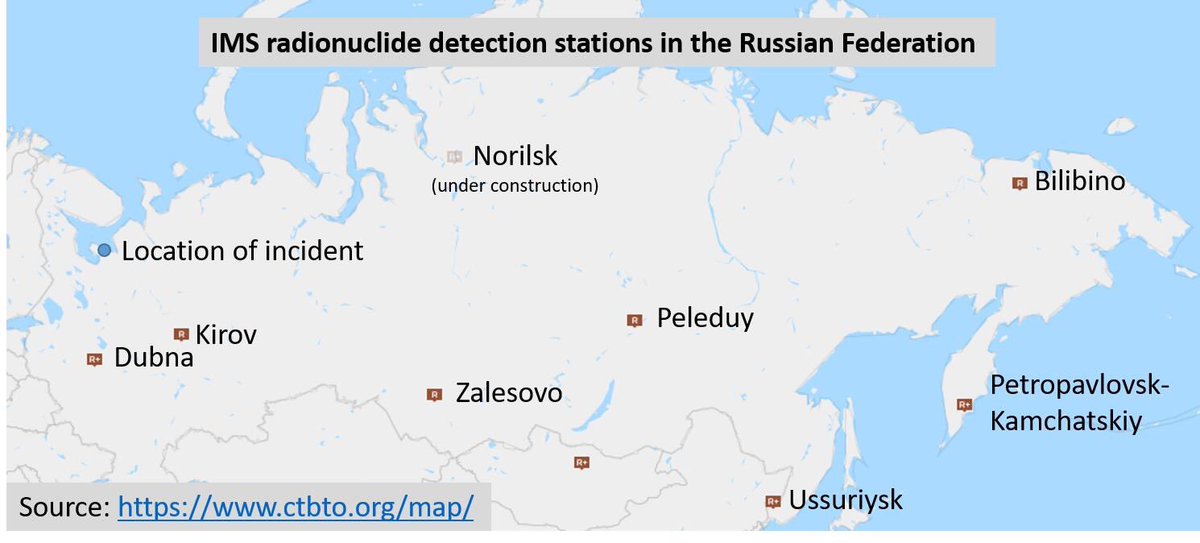

In the morning of 8 August 2019, an explosion occured at the Russian weapons test site Nyonoksa, on the coast of the White Sea. Reports say that it happened on a platform (or possibly barge) over water, and that there are casualties (at least 5) as well as injured (at least 3), according to RT, some of the said to be treated in specialised clinics. Literal quotatations from official Russion sources as reported in the Barents Observer (see links below):
The accident was an explosion while testing a liquid propulsion system. The explosion triggered a fire. CTBTO confirmed an event recorded by one seismic and three infrasound station without publishing details. The image shows the arrival of the signal at 06:00 UTC (09 Moscow time). On external gamma radiation in the city of Severodvinsk (25 km E of the site): Radiation increase peaked between 11.50 and 12.30 local time and was back at normal levels at all location by 14.00. While normal background in the town with a population of 190,000 is around 0.11 µSv/h (microsivert per hour), the levels measured at the monitor on the Lomonosov Street near Lake Teatralnoye peaked at 2 µSv/h.
The tragedy happened while working with the engineering and technical support of the isotope power source in a liquid propulsion system.
According to the Barents Observer,
Speculations have arisen in media about a possible testing of Russia's new nuclear-powered Burevestnik missile (NATO name SSC-X-9 Skyfall) and that something exploded on the missile causing leakages of radioactivity. Burevestnik is said to be powered by a small nuclear reactor.
According to Wikipedia, Burevestnik ("Storm messenger", also a bird's name) is a cruise missile with a nuclear payload and a nuclear propulsion system. It is also said to be related to the Poseidon nuclear-powered and nuclear-armed torpedo. The Wikipedia article on Poseidon speculates that it is powered by a nuclear reactor, but also mention
For this purpose, the Poseidon is believed to be equipped with a toxic cobalt bomb, containing cobalt-60.
The Barents Observer says also that the Burevestnik was first tested at Novaja Semlja, and that US reconnaissance planes sampled downstream air in international air space to look for radioactivity. The test site was then obviously moved to Nyonoksa which is far away from the borders of Russian air spaces, especially towards the East (where the wind will blow most frequently to).
Reports and analysis make it very likely that the accident happened in a test for the Burevestnik. There is no reliable information on the nature of the nuclear propulsion system. Cruise missiles are typically powered by a single jet turbine and may use a rocket motor as booster for start (see Wikipedia on the US Tomahawk. Their mass may be on the order of 1000 kg with 50% payload, and the engine power might be on the order of one or few MW.
Most commentators seem to believe in a nuclear reactor design as power source, including an article in the Russion opposition paper Novaya Gazeta (quoted in Ars technica). The problems of this design are explained in detail in another Ars technica article (see below). It is also at odds with the official statement about an isotope power source. If we look at the power density of isotopes used in radioisotope batteries, we see that Co-60 provides about 20 W/g, or 2 MW with 100 kg. Arguments in favour of this assumption:

Map published on twitter
Lassina Zerbo, CTBTO executive secratary, has released a Twitter message on 18 Aug. It makes publicly known that two relevant CTBTO RN stations in Russia (Dubna, Kirov) stopped transmitting data (also Bilibino and Zalesovo, on 13 Aug according to CNN). ]It also includes a movie showing results from forward atmospheric transport modelling. It shows that
L. Zerbo on Twitter "RN stations RUP 56 (Peleduy) and RUP 57 (Bilibino) have resumed operations in #Russia & are currently backfilling data,"
An article in Bellona reports that Sergei Rybakov, Russia's foreign minister told Interfax
that Russia's transmission of data from radiation stations to the Vienna-based CTBTO was voluntary, and in any case was not subject to the organization's consideration (reported in many other media as well).
They also quote "an unnamed nuclear industry source" with
The four stations may have intentionally stopped transmitting signals to hide the composition of isotopes involved in the accident from other countries
and Daryl Kimball (more of his interesting work) with
It is probably because they want to obscure the technical details of the missile-propulsion system they are trying and failing to develop. But this is not a legitimate reason to cut off test-ban monitoring data transmissions.
There is little to add. Legally, CTBT is not yet in force, and the IMS is under "provisional operation". But it is not a positive perspective to see states acting the way Russia seems to do here.
26 Aug 2019: New reports say that fission products were identified in Severodvinsk: Sr-91, Ba-139, Ba-140 and La-140 (see Article in The Guardian) . This would point towards a nuclear reactor accident. However, it is unclear why these only these specific nuclides were found.
Ars technica: Why Putin's nuclear-powered missile is possible ... and awful
Detailed technical article on the US and Russian attempts to construct nuclear-powered aerial vehicles, on the background of Putin's announcement of an intercontinental-range torpedo and a long-endurance cruise missile
Wikipedia (de) and Wikipedia (en) on radioisotope batteries
Russia Today on the nuclear-powered cruise missile (Feb 2019)